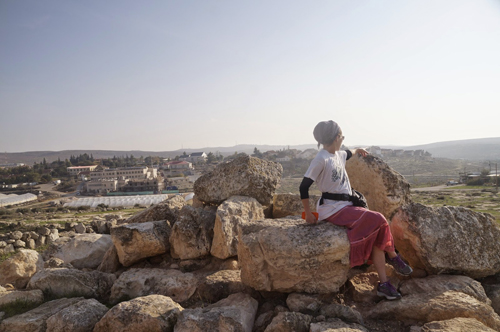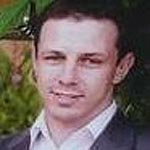
By Sam Litvin

SUSIYA, Israel — It was a most unusual heat on a December morning in the hills south of Hebron. The white rocks stacked in serpentine order reflected light heavenward while the green patches in between them soaked up the rays. The light disappeared inside the ancient caves and cisterns of the old city Susiya. There is no mention of the city in any ancient texts but not far from Hebron, where lies the grave of Abraham, is a town which appeared around the time of the destruction of the Jewish second temple. The town grew and grew, boasting one of the largest and most beautiful synagogues in the area since ancient times, until a mysterious collapse in seventh century.
Its originators were believed to be the priests who fled the destruction of Jerusalem. Here, in exile, they hid inside the caves, created a town, and continued their way of Jewish life. They built ritual baths, cisterns to collect the infrequent rain, carved out caves and later built homes, plowed fields and pressed olive oil. Then, either due to change in climate or some other force, they left the city. Eventually, the city was buried beneath layers of earth until its discovery by British soldiers in the early 20th century.
Today, old Susiya can be seen from new Susiya, a town near surrounded by Bedouin tents. It is populated with expatriates from Netherlands, Israelis and a few Americans. Religious, it boasts a large synagogue built to nearly the exact dimensions of the old one across the ravine. In Susiya there is fire house with one fireman, and a yeshiva (religious high school), known for it’s environmental programs and the warriors it builds. There is also a pool and community center where Natalie Sopinsky teaches Zumba a few days a week.
Sopinsky, with her hair wrapped in a purple head scarf, hops in her long pink skirt with white lace from one rock to another with her young son at her side. Her other four children are at home with their professor dad. She shows me their little village, in which she is the lawyer, the activist, life guard and the day guide at old Susiya. She led me on a tour of Susiya and surroundings, telling me about the settlement that the new pioneers had built.
As I found out, the town is populated not by radicals as I imagined, but families who wanted to get away from the bustle of life in the city. They make wine and grow fresh produce. Many are teachers in local schools. They had to pass interviews and tests to enter this community, including handwriting analysis. The type of people who live here are parents of the kids who become members of the IDF’s elite special forces. The parents here include such heroes as the man who shot and killed a terrorist who was running over people with a bulldozer in the streets of Tel Aviv.
To get here one must first enter the Palestinian territories. Susiya is surrounded by the desert hills of old Judea and new Palestine. Nearly every hill around here is capped with a smaller settlement. The scene is of portable homes with bikes laying out front and clothes hanging and flapping in the wind. From this vantage point, the Negev desert stretches south as far as the eye can see, while to the north, white Palestinian houses with black cisterns dot the hills.
Some residents (including two women) carry guns, while children roam the grounds unescorted. They leave their bikes laying out front since there is no one here to steal.
Israel Feld, the patriarch of the town, with his thick grey beard, t-shirt, large kippa and Teva sandals greets newcomers. He came here from United States in early 80’s to be a farmer and became a father here twelve times.
Are they afraid here? It doesn’t seem so, in that the residents are often seen hitchhiking at the bus stops. But unafraid does not mean they are not wary; watch towers are always manned and guns are at the ready, even if the last attack had been over 13 years ago.
Do they worry about dismantlement of their settlement that my come one day with peace or war? “We don’t think about that. We do not wait and see, if I did that, I would have never gotten married either,” Sopinsky tells me. They try to enjoy each day and take whatever good and bad comes with it. They say they are working for the good, preventing the bad and learning all there is to learn along the way.
Centuries after the old Susiya fell, the new Susiya is alive again, perhaps with the same fervor of the original city, when it sprouted here at the edge of desert away from Roman authority. Here people came to live a free and spiritual life, to provide for themselves and their children and to find a little heaven in the hills
Note from Natalie Sopinsky:
Yeshiva High School specializes in teaching students about the environment and conservation. It is also one of the most efficient and eco-consious minded structures with no need for artificial light during the day. It has solar panels and other energy saving devices.
*
Sam Litvin, originally from Ukraine, is a traveler, writer, photographer and engineer living in San Diego. His articles may be found on the website “Sam the Jewish Guy”
Sam: our son, Menachem Weiss, and his family have lived in Susiya close to 15 years. He and his family grow organic grapes and make wonderful Merlot. He is a Hydro-geologist and works for the Government. Menachem’s wife, Limor, works at the archeological site, and she is the first person a tourist meets as they enter the site. Limor is also a yoga instructor and reflexologist with a clinic in their home. Their eldest son, Avshalom, is now serving in the Army, instructing new soldiers in the art of navigation. In addition, they have a son, Osher, in high school in Jerusalem, a daughter, Gefen, in elementary school, and a married daughter, Gavriel, who has made my husband and I great-grandparents. We visit once a year, and find Susiya a bit of “heaven on earth.” It’s a great place to raise young children, as you surely observed. I hope your article entices many San Diegans to visit beautiful Susiya soon.
Thank you Lois!!!! What a great story! I hope so as well and hope that people gain appreciation for the people who live out in the settlements and understand where they are coming from and their contribution and their holding on to tradition and history.
If you’re interested in getting a book about the travels, please go to my site.
–Sam Litvin, San Diego